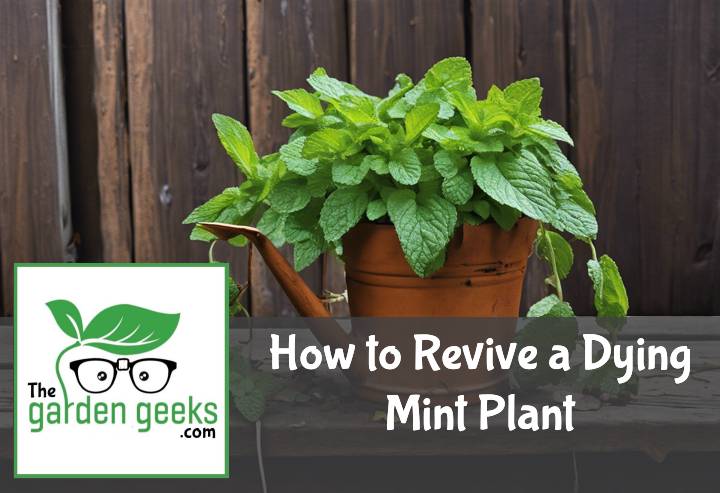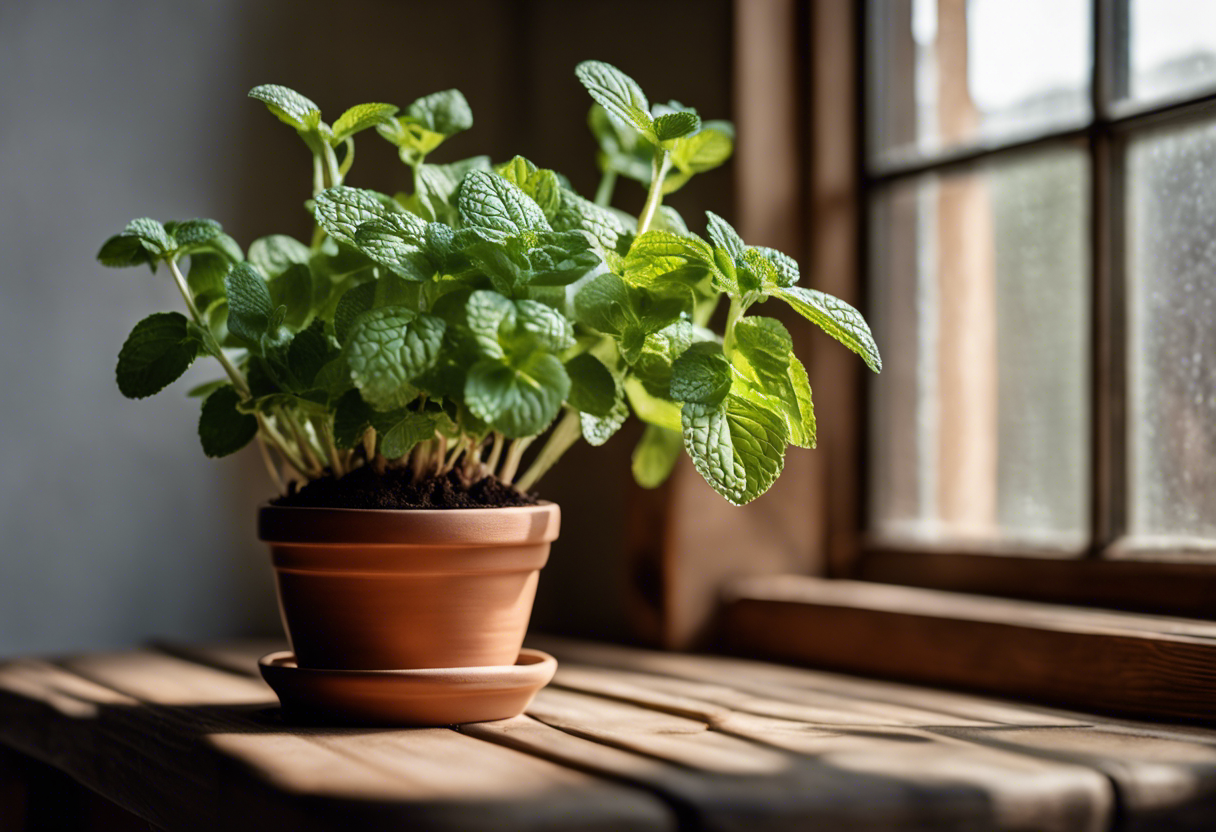I’ve been there, folks, staring at my wilting mint plant and wondering how I could possibly Revive a Dying Mint Plant. It’s like watching your favorite superhero lose their powers on the big screen—heartbreaking!
But fear not! This blog post is your trusty sidekick, ready to guide you through the steps of bringing your mint plant back from the brink. So keep reading about How to Revive a Dying Mint Plant!
Key Takeaways
- Identify the problem: Overwatering, underwatering, or lack of sunlight can cause a mint plant to wilt.
- Correct watering: Mint plants need well-drained soil and should be watered when the top inch of soil is dry.
- Provide adequate sunlight: Mint plants require 4-6 hours of sunlight daily.
- Prune regularly: Remove dead leaves and stems to promote new growth.
- Repot if necessary: If root rot is present, repot the plant in fresh soil.
Understanding the Problem
When it comes to mint plant health, early detection of issues can be a game-changer. It’s like being a plant detective, you’ve got to know what to look for and how to troubleshoot plant care. So, let’s dive into recognizing those pesky signs of an unhealthy mint and understand the common culprits behind its decline.
Identifying Signs of a Dying Mint Plant
Ever looked at your mint and thought, “Something’s off here”? Well, there are some telltale signs of dying mint that you should keep an eye out for. First up, wilted or yellowing leaves. If your mint is looking more mellow yellow than vibrant green, it might be in distress.
Next on our list of unhealthy mint symptoms, check out the stems. Are they weak or brittle? That’s not a good sign either. And don’t forget about those roots! If they’re brown or mushy instead of white and firm, we’ve got a problem.
Last but not least, keep an eye out for any pests. These little buggers can cause serious mint plant distress signals if left unchecked. So there you have it – your guide to recognizing sick mint plants!
Common Causes of Mint Plant Decline
Now that we know what to look for, let’s talk about why your mint might be feeling under the weather. One biggie is environmental factors. Mints are like Goldilocks – they need conditions that are just right! Too much sun or too little water can lead to a serious case of mint decline.
But wait, there’s more! Diseases can also wreak havoc on your mints. Fungal infections are common culprits behind unhealthy mint plants, so keep an eye out for any unusual spots or discoloration.
And lastly, let’s not forget about poor soil quality. If your mint isn’t getting the nutrients it needs from the soil, it can start to deteriorate. So there you have it – a quick rundown of the most common factors causing mint deterioration. Remember, knowledge is power when trying to revive a dying mint plant!
Assessing Your Mint Plant’s Environment
When it comes to mint plant care, the environment plays a key role. It’s like the stage for a Broadway show – if it ain’t right, the performance suffers. We’re talking light conditions, soil quality and drainage, and temperature and humidity.
Evaluating Light Conditions
Now, let’s talk about your mint plant’s spotlight moment. Mint plant sunlight needs are pretty specific. They love a good sunbath but don’t want to be roasted alive. If your mint is turning yellow or looking burnt, it might be getting too much light.
On the flip side, if your mint looks like it’s doing an impression of a wilted lettuce leaf, it might not be getting enough light. Adjusting light for mint plants can be as simple as moving them to a brighter spot or shading them from harsh afternoon rays.
Checking Soil Quality and Drainage
Next up: soil quality and drainage. Think of this as the bed your mint sleeps in every night. The ideal soil for mint plants is well-draining but still holds onto some moisture – kind of like a sponge that’s been wrung out but is still damp.
To check soil drainage, give your plant a good water and see how long it takes to drain through. If you’re left with a puddle after 30 minutes, you’ve got yourself some poor draining soil my friend! But don’t worry – improving soil quality for mints isn’t rocket science; adding organic matter or sand can help fix this issue.
Considering Temperature and Humidity Factors
Finally, we’ve got temperature and humidity – basically the weather forecast for your mint plant. The optimal temperature for mints is between 60-70°F (15-24°C). Anything hotter than that and they’ll start wilting faster than ice cream on a hot day!
As for humidity, mints like it on the higher side. If your home is drier than a desert, consider using a humidifier or placing your plant on a tray of pebbles with water to increase humidity levels. Remember, adjusting temperature and humidity can be the key to revive a dying mint plant.
Reviving Techniques for a Dying Mint Plant
Let’s dive into some tried and true methods to revive a dying mint plant. We’ll focus on tweaking watering habits, adjusting light exposure, and enhancing soil condition.
Adjusting Watering Practices
First off, let’s talk water. Proper hydration is key in mint plant care, but it’s a delicate balance. Too much or too little can send your mint spiraling towards the plant graveyard.
Overwatering is often the culprit behind a wilting mint. Signs of an overwatered mint plant include yellow leaves and a droopy appearance. If you notice these symptoms, ease up on the H2O.
On the flip side, underwatering can also harm your mint. Dry soil and brown, crispy leaves are telltale signs of thirst. If this is the case, it’s time to ramp up your watering game.
In general, aim for moist (not soggy) soil to keep your mint happy and healthy.
Modifying Light Exposure
Next up: light exposure. Mint plants love their sunshine but they’re not sun worshippers per se.
Too much direct sunlight can scorch your mint faster than you can say “mojito”. On the other hand, too little light will leave your plant looking pale and lackluster.
The sweet spot? Indirect sunlight or partial shade works wonders for both indoor and outdoor mints. So adjust those blinds or move that pot to ensure your mint gets just the right amount of rays.
Improving Soil Condition
Last but definitely not least: soil condition. The right soil can make all the difference when trying to revive a dying mint plant.
Mint plants aren’t picky about their dirt digs – they’ll grow in almost anything! But for optimal health, they prefer well-draining soil that’s rich in organic matter.
If your mint is struggling, consider amending your soil with compost or a slow-release fertilizer. This will give your plant the nutrients it needs to bounce back.
Remember, a little TLC goes a long way in mint plant revival. So don’t lose hope – with these tips, you’ll have your mint back in tip-top shape in no time!
Pest and Disease Management
To revive a dying mint plant, it’s crucial to get a handle on pest control and disease treatment. Mint plant care isn’t just about watering and sunlight, but also involves keeping those pesky bugs at bay and ensuring your plant is disease-free.
Identifying Common Pests in Mint Plants
First things first, let’s talk about the uninvited guests that love to munch on your mint. Aphids on mint plants are a common sight. They’re tiny, greenish pests that suck the life out of your leaves. If you see them, it’s time for action!
Next up are spider mites on mint. These microscopic critters leave behind a telltale sign – web-like structures on the undersides of leaves. And then there are whiteflies in mint plants. You’ll know they’ve arrived if you notice small white insects flying around when you disturb your plant.
Don’t forget about caterpillars! If you see holes in your leaves or actual caterpillars chomping down, you’ve got a problem. Lastly, watch out for snails and slugs on mint. They’re nocturnal feeders so look for their slimy trails or nibbled leaves.
Treating Diseases in Mint Plants
Now onto diseases. Fungal issues like powdery mildew can be a real pain for mint lovers. It looks like someone dusted your plant with flour – not exactly the look we’re going for!
Bacterial infections can also occur, causing wilting or yellowing of leaves. Then there’s rust disease – nope, not something from an old car but a fungal infection that causes orange spots on leaf surfaces.
And finally, leaf spot disease can cause brown or black spots on your precious greenery. But don’t worry! With proper care and preventative measures, you can keep your mint plant healthy and happy. Remember, the key to maintaining healthy mint plants is vigilance and quick action at the first sign of trouble.
Preventive Measures to Keep Your Mint Healthy
When it comes to mint plant care, an ounce of prevention is worth a pound of cure. Regular pruning and proper feeding are the cornerstones of preventive measures for plants.
Regular Pruning and Maintenance
Regular pruning? Yes, you heard it right! It’s like giving your mint a haircut. Not only does it prevent your mint from looking like a wild bush, but it also promotes healthy mint growth.
Pruning is more than just aesthetics; it’s about preventing plant diseases too. When you prune regularly, you’re removing potential disease entry points and improving air circulation around the plant. This routine plant care can be the difference between a thriving mint and one on life support.
Proper Feeding and Fertilization
Now let’s talk grub – not for you, but for your mint! Just like us humans, plants need food to grow strong and healthy. And that’s where proper feeding comes in.
The right nutrients can make your mint plant go from “meh” to “marvelous”. But how do you ensure those nutrient requirements for plants are met? Well, maintaining soil fertility is key here.
Organic fertilizers for mints are a great way to feed your plant while keeping things natural. They provide all the necessary nutrients without any chemical nasties. So next time you think about how to revive a dying mint plant, remember: prevention is better than cure!
Minty Fresh Farewell
So, we’ve taken our mint plant from a wilting wallflower to the life of the party, just like turning a couch potato into a marathon runner. Remember, it’s all about the right environment, proper watering and timely pruning.
To keep your green thumb game strong, revisit our guide on how to Revive a Dying Mint Plant whenever you’re in need. Happy gardening!





